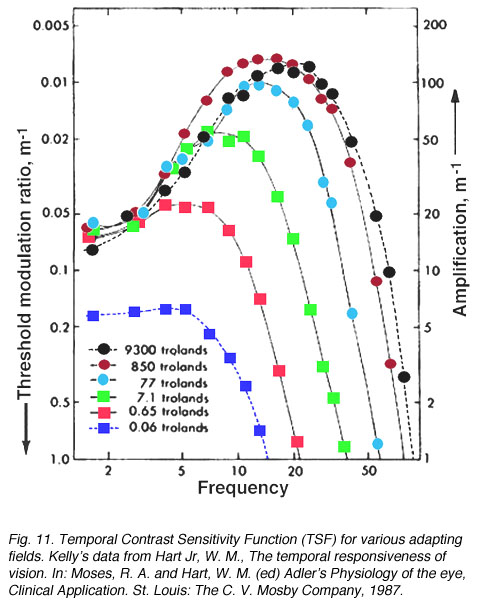Related Topics
Cards In This Set
| Front | Back |
|
Troxler Effect
|
Retinal image stabilization causes a fade invision due to neural adaptation
|
|
Temporal resolution acuity
|
Smallest time interval that can be resolved as flickering light
|
|
Critical flicker frequency; and period
|
Frequency at which a flickering light is perceived as being steady 50% of the time, this is a determination of the temporal resolving capability of the visual system, determined early in visual processing; the length of time taken for one complete cycle of light and dark; amacrine cells are important in this process; highest when eye is light adapted; at good photopic levels wavelength doesn't matter (at lower illuminations CFF varies with wavelength)
|
|
Talbot Plateau Law
|
When a light is flickering above the CFF, the brightness of the flickering light is equal to the time-averaged luminance of the flickering light
Talbot brightness = Lmin + (Lmax - Lmin)xf |
|
Brucke-Bartley phenomenon
|
When the flicker rate is varied without changing the time-averaged luminance, the brightness is enhanced at certain frequencies (5-20 Hz)
|
|
Ferry-Porter Law
|
As the luminance of the flicker stimulus increases, the temporal resolution acuity improves; linear relationship; varies with the wavelength of light and the area on the retina stimulated- law also holds outside the fovea and the slope of the CFF function becomes steeper with eccentricity (periphery has greater temporal acuity then fovea)
CFF = klogL + b |
|
Granit-Harper Law
|
The larger the flickering stimulus, the higher the CFF (temporal resolution acuity improves)
CFF = klogA + b |
|
Temporal Contrast Sensitivity
|
 Indicates how the visual system responds to various combinations of temporal frequencies and contrasts Contrast = (Lmax-Lmin)/(Lmax+Lmin) modulation ratio = (Lmax-Lmean)/Lmean |
|
Temporal summation (Bloch's law)
|
Over short periods of time (30-100 ms) the visual system shows complete temporal summation
L x t = C |
|
Critical duration
|
The amount of time the retina will summate quanta absorbed; this duration is longer under lower light levels
|
|
Broca-Sultzer effect
|
Indicates that the brightness of a suprathreshold flash also depends on its duration
|
|
Brucke-Bartley Phenomenon
|
The brightness of the flicker is enhanced at certain frequencies (even if time averaged luminance remains constant), the maximum brightness enhancement occurs for 8-10 Hz
|
|
Masking
|
Any situation in which the detection of a test stimulus is reduced by another stimulus presented before, during or after the test stimulus; occurs when the times intervals are far shorter than adaptation effects
3 types: background masking, simultaneous masking, forward masking - simultaneous and forward masking are signal detection problems- backward masking is due to the fact that the response to a near-threshold test flash has a longer latency than the neural response to the bright masking flash |
|
Dichoptic masking
|
Occurs when the two stimuli are positioned on corresponding retinal elements of the two eyes; this occurs in the cortex
|
|
Motion detection
|
Limited by the visual system's temporal resolution
- visual system has direction-selective neurons--neurons that respond maximally to motion in a particular direction and not at all in the opposite direction; these neurons can adapt to a moving stimulus - cells in the middle temporal cortex respond well to the rate and direction of spot movements |








